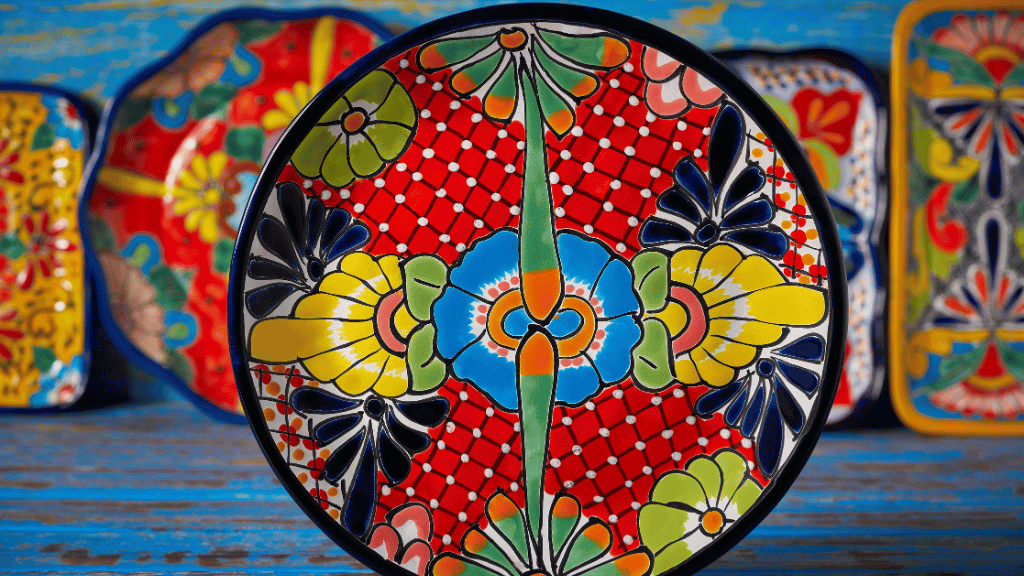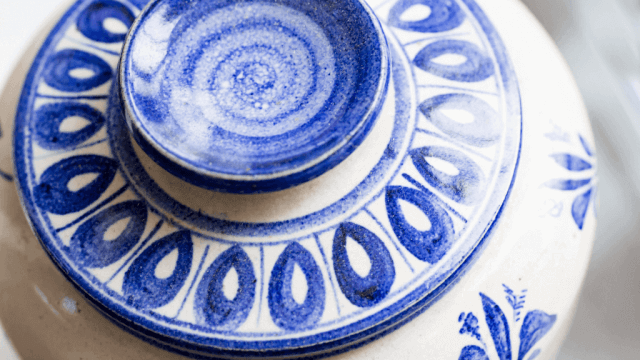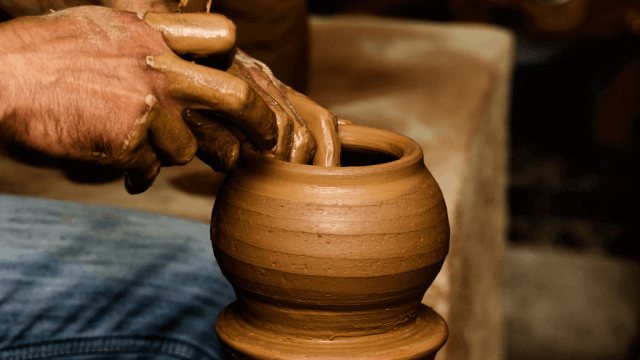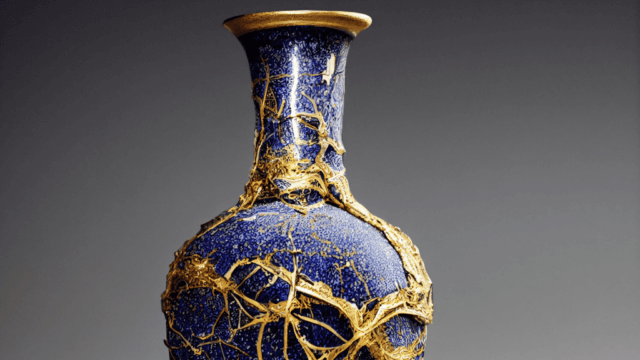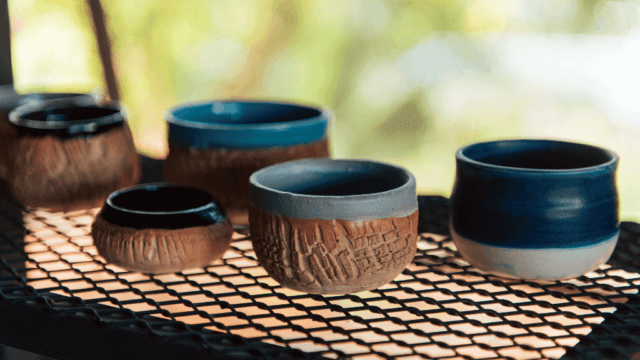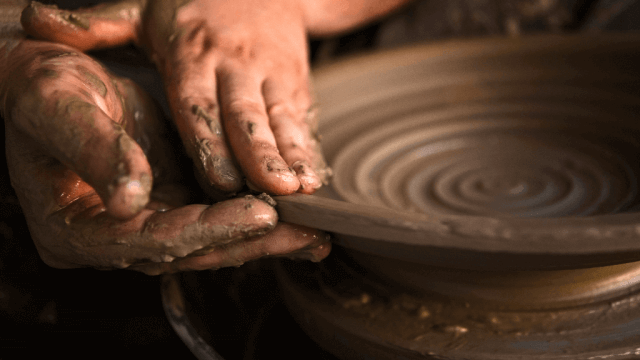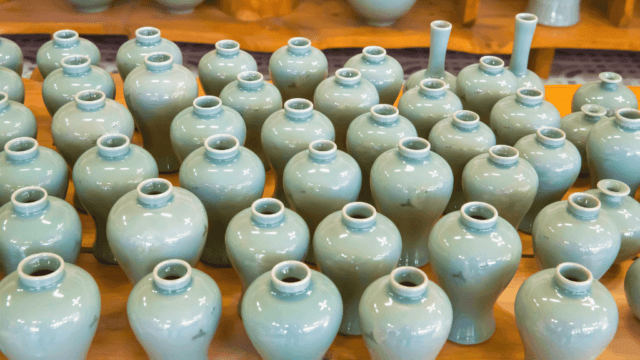Talavera pottery is a type of Mexican ceramic art, originating from the city of Puebla.
Known for its intricate designs, vibrant colors, and durability, it is a popular form of traditional Mexican folk art, used for both decorative and practical purposes.
It is characterized by white glazed backgrounds, cobalt blue patterns, and additional colors such as yellow, green, and orange.
Talavera pottery follows strict regulations to maintain authenticity, including using specific materials and local clay.
History of Talavera Pottery
Talavera pottery traces its roots back to the Spanish city of Talavera de la Reina.
When Spanish settlers arrived in Mexico in the 16th century, they brought their knowledge of pottery-making techniques and introduced the Talavera style to the city of Puebla.
Over time, this art form embraced Mexican influences and evolved into the vibrant and unique style known today.
Making Talavera Pottery
Meticulous craftsmanship and strict regulations are the foundations of genuine Talavera pottery.
All genuine pieces are handcrafted, and artisans follow a rigorous process to ensure authenticity:
Clay Selection and Preparation
Artisans source high-quality local clay from around Puebla, which is then cleaned, soaked, and sieved to remove impurities.
This process can take up to two weeks, resulting in soft and malleable clay suitable for shaping.
Forming and Drying
Using traditional pottery wheels or mold techniques, the artisans shape the raw clay into various forms like plates, vases, and figurines.
Once shaped, the pieces are left to air dry for several days before firing.
Firing Process
The dried pottery is fired in kilns at temperatures of up to 2000°F (1100°C) for around 12 hours, resulting in hardened and durable ceramics.
After the initial firing, the pieces are allowed to cool down before being inspected for quality and any imperfections.
Glazing and Painting
A lead-free white glaze is applied to the fired pottery, creating a smooth canvas for painting.
Talavera pottery is known for its brightly colored, often intricate designs.
Artisans hand-paint the designs using mineral-based pigments, including the signature cobalt blue, as well as yellow, green, and orange hues.
Final Firing
Once painted, the pottery goes through a second firing process to set the glaze, securing the colors and ensuring they do not fade over time.
This also gives the pottery a glossy finish and enhances its durability.
Authenticating Talavera Pottery
To distinguish genuine Talavera pottery from imitations, look for the following markers:
- A “DO4” (Denominación de Origen) certification on the bottom or back of the piece, ensuring it meets the requirements of traditional Talavera production.
- Hand-painted signatures of the artisan or workshop responsible for the piece.
- The characteristic white glazed background and vivid color patterns distinctive to Talavera pottery.
By understanding the history and process behind Talavera pottery, you can appreciate and enjoy the beauty and cultural significance of this Mexican ceramic art.
Variety in Talavera Pottery
Talavera pottery comes in various shapes and forms, reflecting the creativity and versatility of the artisans.
From functional kitchenware such as dinner plates, bowls, and mugs to decorative pieces like wall hangings, planters, and vases, Talavera pottery adds color and beauty to any space.
Crafting unique pieces that showcase intricate patterns, floral designs, and even representations of Mexico’s rich history, Talavera pottery is seen as both practical and decorative art.
Maintaining and Caring for Talavera Pottery
Proper care and maintenance of Talavera pottery will ensure its longevity, allowing you to enjoy your beautiful pieces for years to come.
Keep the following tips in mind:
- Avoid using abrasive cleaning materials, as these can scratch the glazed surface.
Instead, use a mild detergent, warm water, and a soft cloth for cleaning.
- Be cautious of temperature changes when using Talavera pottery for cooking or serving hot food, as rapid changes can cause the pottery to crack.
It is best to use Talavera pottery for cold or room temperature foods.
- Although Talavera pottery is sturdy, it can still break or chip if dropped or mishandled.
Handle your pieces with care and store them safely.
Shopping for Talavera Pottery
When in search of authentic Talavera pottery, consider visiting the city of Puebla and the surrounding area, as this is the birthplace of this beautiful art form.
The city is home to numerous workshops and galleries featuring traditional Talavera pottery.
You can find pieces that display the diverse styles and themes crafted by local artisans.
However, if you cannot visit Puebla, you can also explore online retailers and brick-and-mortar stores that sell certified Talavera pottery.
Appreciating Talavera Pottery as a Cultural Heritage
Talavera pottery reflects the cultural richness and history of Mexico.
Recognized as an Intangible Cultural Heritage by UNESCO, it is not only embraced locally but also appreciated by the international community.
By owning a piece of authentic Talavera pottery, you contribute to preserving and supporting this time-honored craft, while also adding a touch of Mexican artistry and tradition to your home.
Frequently Asked Questions about Talavera Pottery
Here are some common questions related to Talavera pottery that provide additional insights into its history, characteristics, and care.
These answers can help expand your understanding and appreciation of this beautiful Mexican art form.
What makes Talavera pottery different from other types of pottery?
Talavera pottery is unique due to its historical background, strict production process, and colorful patterns.
Originating from both Spanish and Mexican influences, it is characterized by a white glazed background, vibrant cobalt blue designs, and additional bright shades such as yellow, green, and orange.
Authentic Talavera pottery must also adhere to strict regulations and traditional manufacturing techniques specific to the region of Puebla, Mexico.
How can I tell if my Talavera pottery is authentic?
To verify the authenticity of Talavera pottery, look for a “DO4” (Denominación de Origen) certification on the bottom or back of the piece.
This certification means it meets the requirements for traditional Talavera production.
Additionally, genuine pieces usually feature the hand-painted signature of the artist or workshop responsible for the piece, along with the characteristic color patterns and glazed finish distinctive to Talavera pottery.
Can I use Talavera pottery in the dishwasher or microwave?
Although Talavera pottery is quite durable, it’s best to hand-wash your pieces with mild detergent, warm water, and a soft cloth to avoid scratching the glaze.
Avoid using the dishwasher, as the abrasive cleaning agents or high water pressure can damage the pottery.
Talavera pottery is also not recommended for use in the microwave or oven, as rapid temperature changes can cause cracking or damage.
Why is the cobalt blue color so prominent in Talavera pottery designs?
The vivid cobalt blue color is a signature feature of Talavera pottery, originating from the Spanish influence on this art form.
During the initial introduction of this pottery style in Mexico, cobalt blue was a valuable and expensive pigment, which signified the high quality and prestige of the pieces.
Today, the striking blue designs have become a hallmark of authentic Talavera pottery, setting it apart from other ceramic arts.
Where’s the best place to buy authentic Talavera pottery?
The most ideal place to shop for genuine Talavera pottery is the city of Puebla, Mexico, and its surrounding areas, where the art form originated.
Here, you can find numerous workshops and galleries featuring traditional Talavera pottery crafted by local artisans.
If you cannot visit Puebla, you can still find certified Talavera pottery through reputable online retailers or brick-and-mortar stores that specialize in selling authentic Mexican handcrafts.
